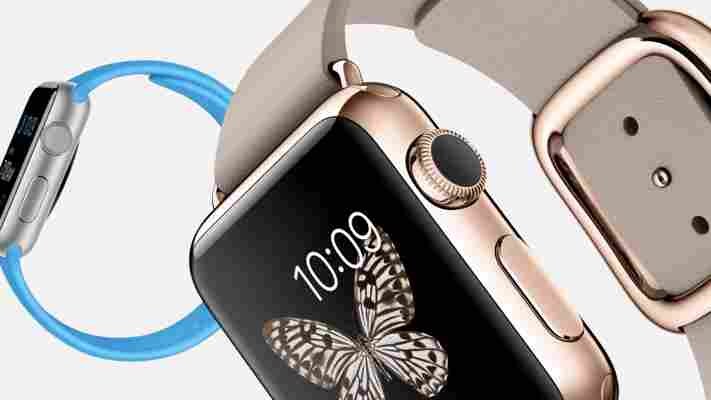“It’s just a fad,” they said. “It’ll never catch on.”

Oh, how wrong they were!
Uptake of wearables has exploded, establishing them as a core category in the Internet of Things. Sales in the US will hit $70 billion by 2024 – they’re already forecast to hit the $5 billion mark by 2018.
Wearables have truly found a niche in the health and fitness market, reflected by the dedicated ‘Fitness and Activity’ category at this week’s IFA in Berlin, Germany’s biggest tech show. In fact, for 45 percent of wearable owners , their chosen piece of on-body tech is a fitness band.
“We started the zone in 2010,” says Dirk Koslowski, IFA’s Senior Executive Director. “It’s become a platform for wearables and a showcase for the latest developments for digital fitness products.”
From gym-rat to life-saving, here are some of the innovations you should keep your eyes peeled for at the show.
Pebble 2 + Heart Rate and Time 2 + Heart Rate
As one of the mainstream pioneers of smart watches, Pebble is showcasing two new Kickstarter funded products at IFA, Pebble 2 + Heart Rate and Time 2 + Heart Rate . Both available now for preorder, they feature a new version of Pebble’s OS.
The operating system, Pebble Health, monitors sleep, step and calorie count to help monitor fitness goals.
Each model has a light-based PPG heart rate sensor that measures skin’s light absorption levels each time the heart pumps, 24/7. Peak Notification, Calendar and Activity Tracking features then feed into your Pebble timeline directly to the watch face.
Pebble 2 + Heart Rate (starting at $99) features a high contrast black and white display plus seven of days battery life. Shipping begins this month. Time 2 + Heart Rate (from $169) has a 53 percent larger color display and a full 10 days of battery life. It’s expected to reach consumers in November.
Added bonus? Both are water resistant to 30 meters and are available on iOS and Android.
Philips Health Watch
With over 100 years of experience in health and wellness technology, it only makes sense that Philips would craft solutions designed around the average person’s health journey.
The company is showcasing the latest addition to its Healthsuite series with its latest wearable – putting medical grade health analytics and activity tracking front and center.
Health Watch , which launched in the US last month, is fully integrated with Philips Healthsuite, a health app connecting to a secure cloud for data analysis.
Continuously measuring biometrics, including heart and respiration rates and sleeping patterns, this clever piece of kit also has automatic activity recognition (choosing between walking, running and cycling), heart rate zone indication and sedentary behavior alerts for when you need to get yourself on the move.
Precision is the name of the game. Heart rate is typically accurate to within 10 bpm, resting heart rate to 3bpm, total energy expenditure at 15 percent accuracy bandwidth and 90 percent success on activity recognition. The numbers shall, indeed, reveal all.
For $249 SRP, you’ll also get a whole lot of watch with an interactive touch ring, alarm, timer, stopwatch, four days of battery life, splash and rain resistance with a beautiful stainless steel finish.
This is certainly a watch you’ll enjoy wearing on a run and to the office.
Run Profiler
After three years of R&D, Digitsole unveils Run Profiler .
A smartsole that measures every aspect of your technique, this thin, ergonomic insole slips right into your running shoe.
At seven grams, it’s hardly going to weigh you down. With real time analysis via its dedicated app (available on iOS and Android), Run Profiler gives you live feedback on metrics including fatigue levels, gait and risk limitation that can help you relearn how to run.
The brainchild of podiatrists and biomechanical engineers, Digitsole’s innovation features four integral technologies: Shock Heel System (SHS) to absorb shock and spread vibrations, Flex-zone to improve foot movement, Arch Support to restore function and X-torsion to optimize stability.
In addition to 3D analysis of stride, gait and posture analysis, this rechargeable smartsole has Bluetooth 4.0 connectivity, 10 days of battery life, 10 hours of memory storage and is available up to a size EUR 47 / US 14. So, no excuses that it doesn’t come in your size.
Run Profiler is available from this month in over 30 countries at $99.
QardioCore
GetQardio is launching its multi-sensor heart rate monitor, QardioCore . Designed to be a lifestyle-friendly medical device, the sleek strap allows for continuous cardio analysis without wires or patches.
Its hard shell encases six layers of next generation ECG monitoring magic.
By measuring body temperature, respiratory rate, activity tracking, heart rate and stress levels, it gives a 360-degree overview of your heart health that can be shared with medical professionals.
The specs for QardioCore are impressive. Weighing in at just 130 grams, including batteries, the lightweight strap is discreet enough to wear under clothes (though possibly not a belly top, sorry). It takes 200 samples a second, withstands an operating temperature range of -20 to 60 degrees Celsius and has up to two days of charge.
QardioCore will soon be available on iOS 8.0 and beyond, and later, Apple Watch.
BeeLine
For intrepid urban cyclists, this nifty handlebar navigation device will get you to your destination without the dictator-style “make a U-turn when possible” nagging.
Available for preorder on Kickstarter , BeeLine strips back navigation to give a more intuitive approach to getting around – though technically it’s your bike that will do the wearing, rather than you.
Strap the device to your bike’s handlebar, choose your destination on the free app (on both iOS and Android) and the display will guide you by bearings, not prescriptive directions. There’s also the option to drag and drop waypoints.
Navigation takes place in real time thanks to a magnetometer, accelerometer, gyroscope and Bluetooth receiver – all pointing you in the right direction.
The display is visible in all conditions (you can tell this was thought up by the British – we shall conquer the rain!) with a crisp e-paper screen plus backlight that is weather and shock resistant. Its high capacity battery lasts up to four weeks with normal usage.
The cycling compass lets you explore your city better, as well as keep track of regular destinations and routes.
Easy access to personal health programs empower individuals make better lifestyle choices. With wearable technology, it’s no longer overwhelming to establish healthy habits.
As with so much in fitness and health, it’s not about the destination, but the journey.
PetBot uses ‘petificial intelligence’ to let your cat or dog send you selfies
How does it feel to be the center of the universe? Don’t know? If you’re a pet guardian, that’s exactly what you are, at least as far as your precious animal companion is concerned. When you’re away, they pine for your return (even cats).

With the Internet of Things becoming more thoroughly intertwined with pet care , a new device called PetBot , is being developed that combines intelligent audio and visual input to let Fluffy or Fido choose when and how to communicate with you — and even send you selfies.
PetBot, which launches a crowdsharing campaign on Indiegogo today, seeks $80,000 in funding for a connected device that lets you and your pet view, interact and communicate with each other throughout your busy day. No longer will you have to suffer through meetings wondering if your dog is lonely or your cat is crying.
PetBot not only lets you observe your friend’s activities, but employs artificial (petificial) intelligence — animal face recognition and bark recognition to alert you when something’s up at home. It lets you communicate by voice, have your pet send you selfies and even dispense treats.
“PetBot is the very first smart pet device that allows your pet to contact you,” Jason Yu, PetBot’s co-founder, told TNW. “We’ve invented pet recognition — a brand new thing. It leverages “petificial” intelligence — AI that can recognize the face of your pet, take a selfie and send the owners a short clip of their pet when they have to be away.”
Place PetBot anywhere in the house and it will identify your dog or cat when they are in the camera’s view. It will then play an audio clip of a sound, or your voice, to entice your friend to come closer to it.
At that point PetBot will begin a 10-second video recording or selfie image to send to the owner’s phone, and also dispense a reward treat. You can easily share photos and videos on Facebook, Twitter, Pinterest and Instagram.
The device features “bark recognition” which recognizes and notifies you of sounds from your dog or cat, letting you stay on top of their training and health care. For example, it can help identify and reduce separation anxiety through your pet’s barking patterns.
“Bark detection lets you be the first to know if your dog is barking or cats are meowing, indicating that maybe something is happening at home and you should check it out,” Yu said.
The treat dispenser is designed to reinforce training while AI features are being improved to interpret behaviors such as if the dog is lying down or the cat is scratching the furniture,” Yu said. “We envision it as motivating, training and mental stimulation exercises and reinforcement for good behavior.”
Integrated Bluetooth tech can connect PetBot to existing wearables such as electronic tags, collars and trackers and upload it to PetBot’s Pet Care Hub, now under development, which will automatically give pet owners additional information.
Other neat extras include the ability to upload pre-recorded audio to ensure pets hear consistent sounds every time. This is especially useful for training.
Yu says PetBot prototypes are also being tested in a network of animal shelters and rescues in Canada to formulate ways the device can help make shelter animals more adoptable — by making cats more social and dogs less anxious. To ease the stressful environment of the shelter, PetBot even has a nature sound that plays at intervals — wind, chirping birds — to simulate a natural and relaxing environment for the cats and dogs after hours when the shelter is closed.
➤ PetBot [Indiegogo]
9 of the best Apple Watch quotes
It is arguably one of the most anticipated Apple products in the history of Apple products, and everybody has an opinion about it.

Some self-proclaimed experts predict tens of millions of Apple Watches sold, per quarter, and others dismiss it as a fad and a dud that doesn’t solve any problem so won’t sell at all. Here’s a collection of interesting quotes from Swiss watch executives, Apple employees and industry watchers. Enjoy.
“We’ve never sold anything as a company that people could try on before.”
– Tim Cook, to sales staff at a London Apple Store, reported by The Telegraph .
“Apple sets prices not based on what people want to pay, but what people are willing to pay.”
– John Gruber on pricing for the Apple Watch
“I think Apple’s contribution has always been at its most significant when it’s trying to make personal products. And this watch is clearly the most personal product we’ve made.”
– Jony Ive in the Financial Times
“Fashion customers are more skeptical than anyone, so Apple has picked a tough crowd.”
– Eric Wilson, fashion news director of InStyle, reported by Reuters
“Obviously Apple is coming into the space and they seem like they’re interested… It says iPhone, Mac, Watch [at the top of Apple’s website] so it’s going to be pretty exciting, but it’s a pretty different product. In some ways, it’s definitely lacking, in quite a few ways, but they’re going after a pretty different market segment.”
– Pebble’s CEO Eric Migicovsky to The Next Web
“It was different with the phone – all of us working on the first iPhone were driven by an absolute disdain for the cellphones we were using at the time. That’s not the case here. We’re a group of people who love our watches. So we’re working on something, yet have a high regard for what currently exists.”
– Jony Ive, in a conversation with the Financial Times
“This watch has no sex appeal. It’s too feminine and looks too much like the smartwatches already on the market. To be totally honest, it looks like it was designed by a student in their first trimester.”
– Jean-Claude Biver, head of brands like Tag Heuer, Zenith and Hublot. Via the Telegraph
Richard Howarth: “The materials in this thing are insane. It’s not glass, it’s sapphire crystal—completely different structure. And then the stainless steel is super-hardened. And the zirconia ceramic on the back is co-finished with sapphire as well. This would cost so much money if a different company was making it—Rolex or something. It would be a hundred grand or something.”
Julian Hönig (jokingly): “We sell it for just fifty thousand”
– Apple designers quoted in ‘ Jonathan Ive and the Future of Apple ‘ at the New Yorker
“Personally, I don’t believe it’s the next revolution. Replacing an iPhone with an interactive terminal on your wrist is difficult. You can’t have an immense display.”
– Swatch CEO Nick Hayek, via Bloomberg
Don’t miss: Apple Pay on the Apple Watch will be smarter than you think
